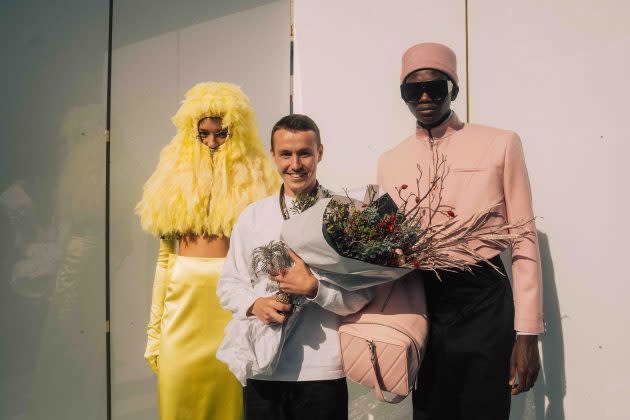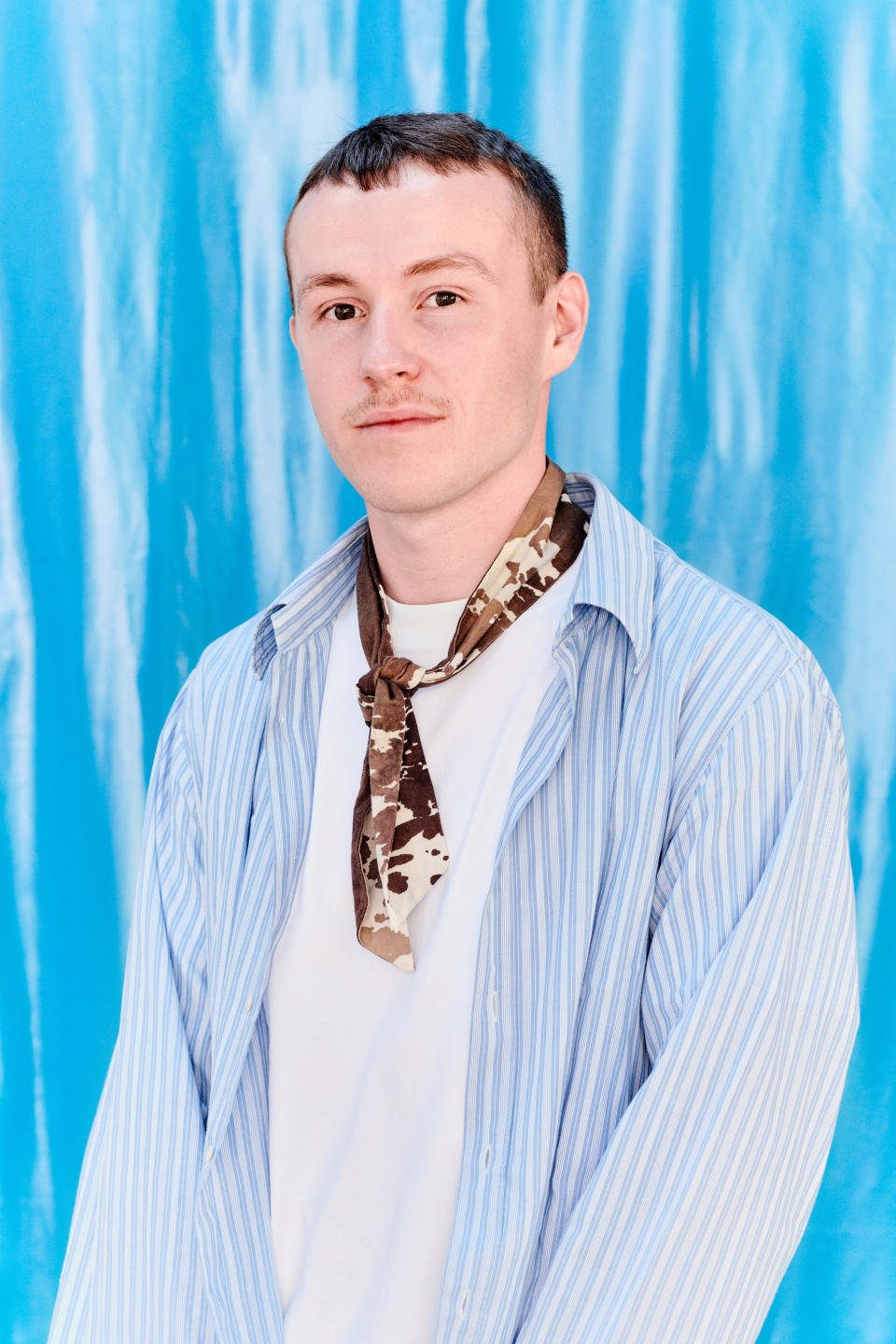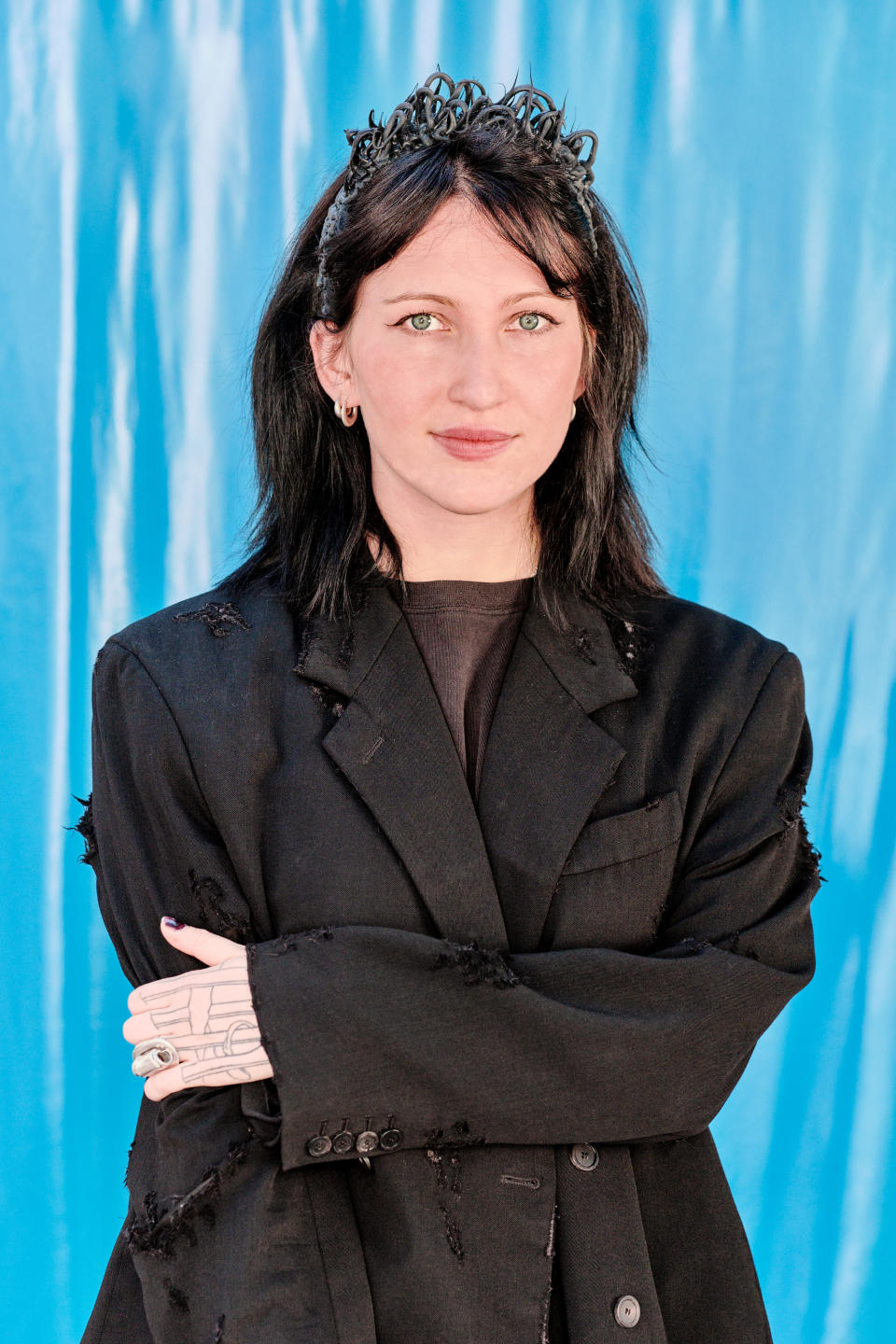Belgian Designer Igor Dieryck Scores Triple Fashion Prize Win at Hyères Festival
- Oops!Something went wrong.Please try again later.

HYÈRES, France — Belgian designer Igor Dieryck won the top prize at the 38th edition of the International Festival of Fashion, Photography and Accessories — Hyères on Sunday, wowing the jury headed by Charles de Vilmorin with chiseled designs inspired by hotel staff uniforms.
Based in Paris, the 2022 graduate of Antwerp Royal Academy of Fine Arts hailing from the south of Belgium is working as a junior designer in menswear at Hermès.
More from WWD
Titled “Yessir,” his unisex collection was inspired by his student job as a receptionist in a hotel, exploring the interactions between people from all walks of life and questioning “the place of hotel staff within their establishment.”
“The uniform is really this idea of adding a layer onto your essence and it modifies the perception people have but not really ‘you,’” he said during the finalists’ showroom.
His work was “a total crush” for the jury, said de Vilmorin lauding “a collection [that was] hyper creative, poetic but also super real and desirable that could stretch into multiple seasons in the future.”

Among the standouts were the opening look, a groom clad in a cropped jacket and trousers with a high waistline that gave legs for days and a jaunty pillbox hat; trousers with a trompe-l’oeil mashing extreme baggy jeans, tailored slacks and boxer shorts, and a jeans jacket that was a millefeuille of materials both casual and delicate.
Thanks to a down jacket with a hood inspired by a feather duster, crafted in collaboration with Lemarié, Dieryck also scooped up the Le19M Métiers d’Arts Prize in partnership with Chanel, which comes with a 20,000-euro purse for a project to be exhibited at next year’s festival.
The L’Atelier des Matières Prize and its 10,000 euros worth of materials went to Sweden’s Petra Fagerstrom, for her work inspired by her grandmother, who was a parachutist in the former Soviet Union.

She impressed by developing a technique to create lenticular images in fabric using pleating, used to express the duality between the reality of, say, a floral nightgown and one’s dreams. In her grandmother’s case, it had been a mental image of California as a “utopian eternal sunset” taken from a postcard, juxtaposed with her life under a totalitarian regime.
Cut from materials that included an upcycled parachute and deadstock leathers, the “Grand-mère Volante” collection also netted Fagerstrom the Mercedes-Benz Sustainability Prize, which distinguishes the designer who best applied eco-conception practices in their work.
Fagerstrom, who intends to launch her brand and is in the Swedish Fashion Council’s five-year incubator program, is also keen to find partners in textile innovation and sustainability to further her research in those fields.
The edition had been particularly diverse in inspiration, with designers digging deep into themselves to talk about how they felt in their bodies, processing grief or the global geopolitical context. “They were boundlessly generous, inspired by joyful moments or difficult episodes,” de Vilmorin said.
Given his age, the 26-year-old fashion jury president saw the competition “more as an exchange than a judgment on their work,” saying he’d been particularly drawn by those whose work allowed him to project how they’d evolve in “two, three, 10 years.”
The accessories grand prize went to Swiss designer Gabrielle Huguenot, for designs she described as “impetuous and vengeful” that ranged from unwearable shoes that had spikes inside and outside, to spiny jewelry and bags that looked halfway between practical and potentially lethal.
“Apart from the work, there’s a world around her. You could see that she knows already who she is and is confident in that,” accessories jury president Alan Crocetti said. While her work was intricate and close to art pieces, the jury could see it translating into a commercially viable reality. She embodied the advice of “keep doing whatever crazy things are in your head but understand that people should be able to have it as accessories — it’s a balance,” that he’d give for anyone looking to establish a brand.
German designer Christiane Schwambach received a special mention from the accessories jury.
Victor Salinier, a graduate of Geneva’s HEAD fashion school, rose to the challenge of using only leather for an accessory of their choice for this year’s Hermès prize submission, a constraint that encouraged designers to step outside of their creative universes, said the French luxury house’s creative director of fashion accessories Clémande Burgevin Blachman.
She lauded Salinier’s use of leatherworking crafts but also the “great poetry” of his headdress that evoked a child perched on their parent’s shoulders.
Blachman noted that candidates leaned toward innovation and experimentation, had often rooted their submissions in childhood memories and considered notions of beauty and ornamentation.
As is now tradition, finalists will be exhibiting their work in Paris on Wednesday and Thursday as part of the annual Supima Design Lab, alongside the works of the 2023 Supima Design Competition finalists and a selection of designers including including Niccolò Pasqualetti, Victor Weinsanto and Vincent Pressiat.
In photography, Paris- and Lausanne, Switzerland-based Thaddé Comar scored the 7L Photography Grand Prize with his work documenting the 2019 protests in Hong Kong, exploring in particular the devices used by demonstrators attempting to mitigate increasingly sophisticated methods of control.
The American Vintage prize went to self-taught Senegalese artist Souleymane Bachir Diaw, who is based in Paris, for “Sutura, the silent voice of men,” questioning masculinity through a wardrobe in motion. Kin Coedel, who lives and works between Paris and Shanghai, won the public photography prize.
In addition to the runway shows and the fashion, photography and accessories competition, there were also plenty of workshops, book signings and musical performances to keep visitors entertained throughout the weekend in Hyères.
Among the exhibitions remaining open to the public until Jan. 14 were “Esprits Libres,” with a recreation of designer Stéphane Ashpool’s studio as he creates looks for the French national team ahead of the Paris Olympics in 2024, and “Les Nuits d’Été,” (or “summer nights”), where designer Pierre Yovanovitch reimagined the summer residence of the Noailles couple.
Delving into the house’s archives, he matched his finds with new commissions to recreate a surreal bedroom, boudoir or music room — the ideal setting for “Garde-Robe(s),” curated by Emilie Hammen with pieces ranging from a recreated Chanel haute couture dress from fall 1930 to a bespoke Ester Manas design.
Throughout the Villa were also dozens of portraits of Marie-Laure and Charles de Noailles by contemporary artists.
Creating using the tools and languages of the times was at the heart of the roundtables organized by the Fédération de la Haute Couture et de la Mode, which looked at artificial intelligence for this edition.
“You have to appropriate AI and not the other way around,” was the lesson the FHCM’s executive president Pascal Morand wanted the audience to remember.
Participants, including Launchmetrics chief executive officer Michael Jais; Laurence Devillers, professor of artificial intelligence at the Sorbonne university and member of the digital ethics committee; Eric Peters, deputy head of unit in charge of the European Commission’s Strategy for the Digital Decade 2030, and Meta’s global head of luxury Morin Oluwole, went over the latest innovations in this domain and new models; the ethical, social and legal challenges of generative AI, and the opportunities it brought for creation.
“The prompt is a tool just like looms or sewing machines,” said Denis Bonnay, an associate professor in philosophy at Paris Nanterre University, highlighting AI’s capacity to “find a form of coherence we wouldn’t have expected” from seemingly disparate elements.
Engineer, entrepreneur and artist Paul Mouginot said AI was “a tool, not a medium” and insisted on the importance of having a personal vocabulary to feed into AI models.
Humans aren’t quite surplus to requirements yet, agreed Samuel N. Bernier, leader of design and innovation at digital transformation consulting firm Onepoint. “We have the idea that AI will continue progress without us but it needs us to feed it. If we give it its own production, it tends to go around in circles or even collapse.”
Speakers also often pointed out how embedded AI already is in our everyday life, be it Amazon shopping recommendation or fraud detection.
The prizes were a highlight of the weekend in Hyères, but the four-day event was also an opportunity for industry newcomers and insiders to meet and form lasting links.
Icicle president Vanessa Yao revealed that’s how the brand tapped 2021 winner Ifeanyi Okwuadi, who has since joined its Paris design studio.
Meeting the other finalists was an outcome Finnish finalist Leevi Ikäheimo was already pleased with ahead of the results. “Even though our aesthetics are totally different, we have the same values, passion and care for [the] future. If and when we go places, becoming people who have power decide, I want to believe we will use it to make this industry better – more sustainable, socially sustainable and more inclusive.”
Festival founder and general director Jean-Pierre Blanc said this edition highlighted “the generosity and the importance of youth,” which is the essence of the festival created in 1985.
While he wouldn’t be drawn into speculating on what kind of career awaited the contestants, he noted “many things [are] possible today in fashion weren’t 20 years ago,” such as the appointment of Botter’s Rushemy Botter and Lisi Herrebrugh to the creative helm of Nina Ricci in the wake of their Hyères win in 2018.
The fashion, photography and accessories festival has helped raise the profiles of talents such as Viktor & Rolf; Saint Laurent artistic director Anthony Vaccarello, and Paco Rabanne’s Julien Dossena.
Blanc was also left touched by this year’s young jury presidents “giving as much to the public but also the youth they will see over the weekend,” through exhibitions, masterclasses and jury sessions, saying it matched Charles and Marie-Laure de Noailles’ proclivity for very young artists for this edition during the Villa Noailles centenary.
“The Salvador Dali and Alberto Giacometti [they commissioned] weren’t ‘Dali’ and ‘Giacometti’ we remember today, they were talented 20-somethings,” he said.
Launch Gallery: Igor Dieryck Scores Triple Fashion Prize Win at Hyères Festival
Best of WWD

